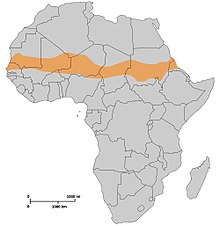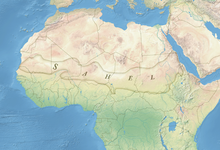Sahel
The Sahel is a narrow belt of land in North Africa. It is a strip of land about 5500 kilometers long and 450 kilometres wide. It lies at the southern edge of the Sahara Desert




The Sahel has a tropical semi-arid climate. It is between the dry desert land to the north and the forest areas to the south. The temperature is high throughout the year. There is little rainfall in the Sahel (between 100 and 150 mm and 600mm). It comes during summer months and may be unreliable. It may be very dry in some years, especially if a large area of low pressure, which brings rain, is not carried North over the Sahel by strong winds.[1]
Sahel is the Arabic word for 'edge' or 'shore'.
The Sahel is facing a big problem, desertification. The distribution of rainfall in the Sahel region is uneven. The rainfall in the region has been below average since 1970. The Sahel is becoming drier on the whole. The problem of drought affects most of the countries in the Sahel. As a result, crops and animals die. There is no vegetation to protect the soil, which is then removed by flash floods and strong wind. This leads to soil erosion. Finally, the desert spreads towards the surrounding areas.
With better medical services, the birth rate increases and the death rate decreases in the Sahel. As a result, the population in the Sahel is growing. To meet the ever-increasing demand for firewood, a lot of trees have been cut down. More land has become barren. This is called deforestation.
Furthermore, people farm intensively in order to grow more crops, the soil becomes infertile with a lack of nutrients. If this process continues for a long time, no crops can be grown. This is called overcultivation.
People keep animals for food due to the lack of good soil, the animals will have to eat grass and etc. But as the animals eat the grass, they also dug up the soil. As people keep too many animals, the demand for grass is too great. Soil erosion is caused while the animals keep digging the soil up as they eat, and the wind and rain blow away the soil. This process is called overgrazing.
Modern solutions can be used to give a better agricultural result in the Sahel. We can try drip irrigation or hybrid. We should stop using excessive water and consider our actions, to save the Sahel and lake Chad before it is too late.
References change
- ↑ Azam (ed) 1999. Conflict and growth in Africa: the Sahel. Organisation for Economic Co-operation and Development. ISBN 92-64-17101-0